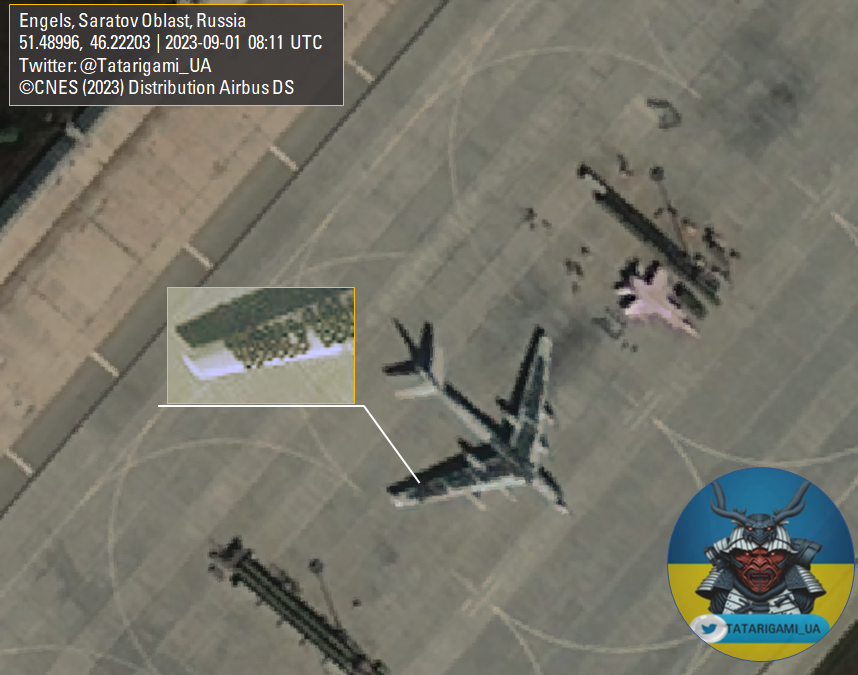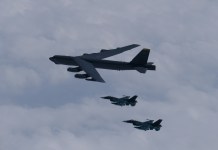In a move that has garnered widespread attention, satellite images circulating on social media have revealed that the Russian military has resorted to a rather unconventional method of protecting its Tu-95 strategic bombers.
Satellite images posted on the social media platform X (formerly Twitter) on September 3 showcased that the Russian military has seemingly placed surplus car tires on the wings and fuselage of their Cold War-era Tupolev Tu-95 strategic bombers at Engels airfield.
The satellite image, initially posted by the X user Tatarigami_UA, who identifies as a Ukrainian military officer in reserves, indicates that Russian forces are adopting this tactic at the Engels military airfield, located approximately 500 miles (over 800 kilometers) southeast of Moscow, with the apparent aim of deterring drone attacks.
This approach is likely a response to the increasing danger posed by drone and missile attacks within Russia, exemplified by a recent incident where four Russian Il-76 military transport aircraft stationed at an airfield in the western city of Pskov were reportedly destroyed in an attack.
Although Ukraine’s military intelligence agency (GUR) reported this incident, it did not claim responsibility, aligning with Kyiv’s policy of disassociating itself from attacks on Russian territory.

While sharing the photo, the X user Tatarigami_UA said, “Prepare yourselves, as the Russians have demonstrated unparalleled innovation once again. What you’re seeing in this satellite image is a TU-95 strategic bomber enveloped in car tires. According to them, this is meant to protect strategic bombers from drone threats.”
Tatarigame_UA shared additional images, highlighting that this wasn’t an isolated incident, and proposed that it might be the Kremlin’s endeavor to establish a “cost-effective alternative to ERA substitute” — to explosive reactive armor commonly used to counter anti-tank weapons.
The airbase where this improvised solution is implemented holds immense significance for the Russian Armed Forces.
Engels-2 stands as one of Russia’s crucial airbases, serving as the home base for the 121st and 184th Heavy Bomber Aviation Regiments, responsible for operating the Russian Aerospace Forces’ Tu-160M Blackjack and Tu-95M Bear strategic bombers, respectively.
The base faced an attack in the early hours of December 5, 2022, damaging two Tu-95s. On December 26, 2022, a subsequent attack on the Engels airbase claimed the lives of three Russian Armed Forces officers.
A Makeshift Countermeasure?
This marks the latest instance of Russia’s improvised efforts to safeguard its military assets through resourceful means, reminiscent of analogous strategies applied in different contexts.
Ukrainian tank crews, for instance, resorted to installing steel cages onto their turrets as a countermeasure against the looming threat posed by “kamikaze drones.”
These low-tech solutions have proven relatively effective for tanks and other armored vehicles, demonstrating the adaptability of military forces in responding to evolving threats.
However, the same level of efficacy cannot necessarily be attributed to the straightforward placement of tires on the tops of bombers.
Nevertheless, the precise reason behind this move remains shrouded in uncertainty. Numerous reports and accounts indicate that the Russian Aerospace Forces have embraced this unconventional approach in response to the escalating menace of Ukrainian drones.

Previously, the Russian Navy had applied paint to the front and rear sections of its Admiral Grigorovich-class frigates due to the persistent maritime drone attacks on these warships while anchored in the harbor.
In addition to drone attacks, Ukrainian missile strikes present challenges for Russia. Modified versions of the S-200 and Neptune missiles have been reportedly deployed to target critical infrastructure and assets within Russian territory.
Hence, the application of tire coverings on these aircraft might be a deliberate strategy to disrupt the infrared signature of the bombers, thereby confounding cruise missiles that rely on image matching for precision targeting.
Describing it as “drone tire armor,” Trent Telenk, a former personnel of the US Department of Defense, highlighted that overburdening older Cold War-era aircraft designs with numerous tires attached to their wings and subsequently filling them with fuel can negatively impact the wings that are not adequately maintained or have been excessively used.
In the meantime, the decision to employ tires as a protective measure garnered ridicule from Ukrainians.
A user on the X platform humorously quipped, “So, after his 4th bottle of Vodka, the Russian commander suddenly screamed — ‘Let’s use highly flammable car tires to protect the bombers from drones.'”
Another user said, “If your drone bounces off the tires, it can’t damage the plane. If an explosion flips the plane, it will land on the tires, mitigating the damage. Duh. Why didn’t we think of this with our billion-dollar consultants?”
Nonetheless, despite the somewhat unconventional tire addition and the potential ridicule it may invite, these measures are likely regarded as a necessary inconvenience.
Russia’s strategic bomber fleet represents a valuable and finite asset crucial to the nation’s strategic deterrence capabilities. Furthermore, it plays a vital role in Russia’s ongoing “special military operation” in Ukraine, which has continued for over a year and a half.
In this context, safeguarding these bombers against emerging threats is paramount, even if it means resorting to unconventional protective measures.
- Contact the author at ashishmichel(at)gmail.com
- Follow EurAsian Times on Google News




